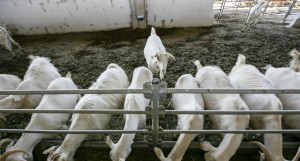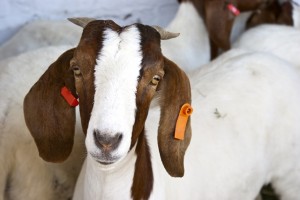Goat Diseases
Clostridial Disease in Goats
Also known as Clostridia, Clostridium Perfringens Type D, Tetanus, Enterotoxaemia, and Overeating disease
Clostridia spp. are a group of bacteria widely recognised as pathogens of livestock, companion animals, wildlife and humans. This group of bacteria can be normal inhabitants of the intestines of most animal species. They are capable of producing spores that can survive in the environment for long periods. Intestinal infections of C. perfringens in livestock are generically known as ‘enterotoxaemias’ because potent toxins are produced in the intestine and may cause disease locally or can be absorbed into the general circulation (Uzal and Songer, 2008).
Clostridium perfringens can produce up to 15 toxins in various combinations, and are divided into 5 main types (A, B, C, D & E) depending on the toxins they produce (Uzal and Songer, 2008). The table below is a summary of the differences between the different types (A – E), the associated clinical signs and geographical distribution taken from published literature. A number of Clostridia spp. (including Clostridium tetani, and Clostridium novyi) are capable of causing disease in goats but the most important is Clostridium perfringens Type D.
| Clostridium perfringens(toxin) type | Toxins produced | Clinical Disease | Clinical Signs | Geographical Distribution |
|---|---|---|---|---|
Type D(most important in goats) |
Produces alpha and epsilon toxins |
Most common enterotoxaemia (with neurological signs) in goatsLinked to sudden dietary change, and has been linked to other factors which alter the intestinal environment such as heavy parasite burden, and drug overdoses. |
Neurological and respiratory signs including blindness, opisthotonos, convulsions, bleating, frothing at the mouth, and recumbency with paddling.Acute form is seen frequently in unvaccinated goats.Per-acute form is seen more in adult goats, and may result in death with 2-4 days.Some vaccinated adult animals may exhibit chronic disease – clinical signs include profuse watery diarrhoea often containing blood and mucus, weakness, and anorexia. |
Worldwide |
| Type A** | Produces predominantly alpha-toxins | Enterotoxaemia
‘Yellow lamb disease’ (largely reported in sheep mainly |
Depression, anaemia, icterus and haemoglobinuria | Rarely seen in N America nut reported in S America, Europe and the rest of the world |
| Type B* | Produces alpha, beta and epsilon toxins | Haemorrhagic enteritis – multifocal, necrotic, predominantly in the ileum. | Abdominal pain, bloody diarrhoea Loss of condition, depression, reluctance to suckle |
|
| Type C* | Produces alpha and beta toxins | Haemorrhagic enteritis – multifocal, necrotic, predominantly in the ileum. Largely affects animals with low levels of trypsin (such as newborns). In sheep known as Lamb dysentery. |
Abdominal pain, bloody diarrhoea | Europe, S. Africa and the Middle East |
| Type E* | Produces alpha and iota toxins | Cases enterotoxaemia however very rare in goats, only reported in the scientific literature once (Kim et al., 2013). |
* Very little information has been published on this disease in goats.
** Type A enterotoxaemia has been reported in goats, although it is very rare (Russell, 1970).
This table is adapted from (Songer, 1998; Uzal and Songer, 2008).

Clostridia spp. are part of the normal gut flora in most animals. A sudden dietary change or the onset of stress can result in the rapid increase the number of clostridia in the gut.
Clostridia perfringens Type D
Clostridium perfringens Type D are normally found in low numbers in the small and large intestine of goats, and when they remain in low numbers they don’t appear to do much harm. However, changes to the gut environment brought about by sudden changes in diet or stress can cause the organism to rapidly multiply in the gut, with the production of increasing amounts of toxins that can be absorbed into the blood causing toxaemia.
Clostridium perfringens type D is a common cause of death goats worldwide (Veschi et al., 2008), and it can develop at any age. In goats the disease occurs in three forms per-acute, acute and chronic (see table above).
- Per-acute infection results in sudden death in a matter of days.
- The cardinal clinical sign of the acute and chronic forms is bloody diarrhoea (Uzal and Kelly, 1996). Goats are often very vocal and show signs of abdominal pain such as kicking their stomachs. Other signs of toxaemia include collapse, shock and convulsions.
- In chronic cases toxins will have caused damage to the gut lining resulting in poor absorption of nutrients leading to weight loss and wasting, and the passing of pasty faeces (Harwood, 2006). The escalating presence of C. perfringens type D in the small bowel, together with a sudden change to a diet rich in carbohydrates, over-feeding cereals, or introduction of lush grass or other vegetation, and stress are the main predisposing factors for the disease (Harwood, 2006; Uzal and Kelly, 1996).
Another type of Clostridial infection of goats to be aware of is Clostridium tetani.

Small wounds such as those created when ear-tagging goats are potential entry sites for bacteria such as C. Tetani. Hygienic tagging minimizes the risk of bacterial infection and includes using a clean applicator, remove any debris from the ear, ensure tag is placed correctly, and observe the animals over the next few weeks for signs of infection.
Clostridium tetani in Goats
Tetanus, caused by C. tetani is not host-specific and usually caused by a contamination of a wound with soil, but practices such as castrating and ear tagging may also be initiating factors (Songer, 1998). The initial wounds may be minor but if infected by C. tetani, the bacterium will produce a potent neurotoxin. The incubation period varies depending on the strain of C. tetani, and may range from 24 hours to 2 weeks (Wellhoner, 1982). Toxins enter the motor nerves and cause clinical signs such as tremors, impaired head and neck function, and difficulty in chewing and swallowing. Spasms give way to permanent rigidity, breathing becomes difficult and death is imminent.
Passive immunity (e.g., transferal of maternal antibodies from the mother via the placenta or from the colostrum) provides 2 – 3 month immunity against tetanus.
For treatment of Tetanus click here.
Control and Prevention of Clostridial Infections in Goats
As clostridia are part of the normal gut flora it is impossible to eliminate them it from the farm. Disease occurs when the numbers of bacteria rapidly increases and the hosts immune system is unable to cope. This often occurs as a result of stress, or a sudden changes in diet. Maintaining a steady diet is important in limiting the risk of an outbreak. When feeding high risk feeds (e.g. high in sugar or protein) be cautious and divide the daily ration into as many small feedings as practically possible, to avoid overeating. Also feed rough forage beforehand to limit the potential over-eating.
If you do want to change the animals’ diet, ensure that you do so slowly and gradually (Harwood, 2006) as to limit onset of disease.
Vaccination against clostridial diseases in goats
There are effective vaccines against Clostridia spp. available for goats. Regular vaccination against clostridial diseases is advised on larger commercial units. Lambivac (MSD Animal Health) or Heptavac P (MSD Animal Health) are used in goats. The primary course is as indicated in the data sheet, but boosters should be given at least every 6 months. In pregnant does a booster dose should be given 4 weeks prior to kidding to boost colostral immunity.
Treating Clostridial infections in Goats
Success of treating Cl. perfringens Type D in goats depends on the stage the disease has reached before treatment begins (Harwood, 2006). More severe cases can be effectively treated with fluids orally or intravenously, along with pain relief and anti-inflammatory agents. Pulpy kidney anti-serum can also be useful. Milder cases may respond to probiotics.
Treatment of tetanus cases is difficult, and the response is usually poor. Full doses of antibiotics, such as products containing penicillin, can be administered to eliminate the bacilli. Tetanus antitoxin should also be given. Success often depends on good nursing with forced feeding (via stomach tube) if necessary. If the infected wound can be found, it should debrided and treated with hydrogen peroxide.
Good Practice Based on Current Knowledge
- Maintain a balanced diet, avoiding feedstuffs rich in carbohydrates
- Avoid any sudden changes in diet, ensure any changes are gradual
- Minimise stress
- Any wounds should be treated
On farms where clostridial diseases are a problem:
- Implement a vaccination strategy for all animals – seek advice from your farm vet
- Good hygienic measures should be maintained during kidding and castration as to avoid infection


 American English
American English

Comments are closed.